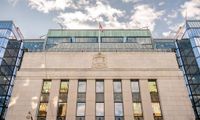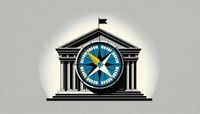The Bank of Canada (BoC) is gearing up for a significant interest rate decision on April 16, 2025, amid a backdrop of global economic uncertainties and domestic inflationary pressures. The central bank is contemplating a potential rate cut, following an 'insurance cut' implemented in March aimed at preemptively addressing concerns over tariffs and their impact on the Canadian economy.
As the nation navigates these choppy waters, the BoC faces a challenging balancing act between fostering economic growth and managing inflation. Current market sentiment indicates a 55% probability of another rate cut, as reported by RBC, reflecting the cautious optimism among economists regarding the central bank's next steps.
Recent developments in the bond market have added to the complexity of the situation. The Canada five-year bond yield saw a dramatic drop to 2.4% before stabilizing around 2.8% by April 10, 2025. This volatility is largely attributed to investor behavior during turbulent stock market conditions, where many sought the relative safety of bonds. Ron Butler, founder of Butler Mortgage in Toronto, noted that the yield levels are significantly higher than they were in previous months, suggesting that mortgage rates, which are closely tied to bond yields, may soon increase.
Butler cautioned prospective homebuyers to secure their mortgage rates now, as the current market dynamics could lead to rising costs in the near future. He highlighted that the market has now priced in a 50% chance of a BoC rate cut next week, a decrease from the 70% odds predicted before the recent turmoil triggered by U.S. tariff policies.
Despite these economic signals, the BoC is under pressure to respond to the ongoing challenges posed by tariffs on U.S. goods, which now total approximately $60 billion. The psychological impact of trade disputes has begun to weigh heavily on consumer sentiment, complicating the bank's decision-making process. David-Alexandre Brassard, chief economist at CPA Canada, emphasized that inflation data set to be released just a day before the rate announcement will play a crucial role in shaping the BoC's strategy. He remarked, "Inflation will play a key role in the Bank of Canada’s decision next week, determining whether February’s inflation rebound was a temporary blip or the start of a longer-term trend."
Economists are divided on the potential outcomes of the upcoming rate decision. While some, like Brassard, anticipate a cut, others advise caution. Claire Fan of RBC Economics warned that the BoC is likely to proceed with care, considering the impacts on both growth and inflation, and suggesting that fiscal policy may be a more appropriate initial response to trade-related economic weakness.
Maria Solovieva, an economist at TD Economics, echoed this sentiment, stating, "Despite the rise in short-term inflation expectations now, there is no evidence of a sharp rise in longer-term views, leaving the door open for another cut in April." This reflects a broader consensus that while inflation remains a concern, the immediate economic environment may necessitate a more aggressive approach from the BoC.
As the April 16 decision approaches, all eyes will be on the BoC as it navigates these complex economic waters. Investors and consumers alike are keenly aware of the implications of the central bank's actions, particularly in light of the recent fluctuations in the stock and bond markets. The forthcoming inflation data on April 15 will provide critical insights into how the BoC might adjust its policies in response to both domestic pressures and global economic trends.
In summary, the Bank of Canada stands at a crossroads, with potential rate cuts on the horizon as it grapples with inflation and the fallout from international tariff disputes. The decisions made in the coming days will not only shape the immediate economic landscape but will also set the tone for Canada's financial future amidst a backdrop of uncertainty.






